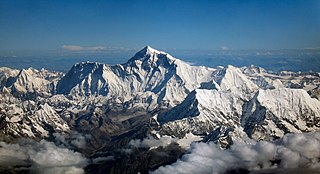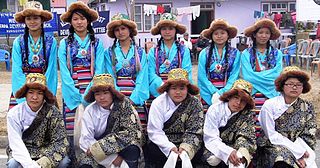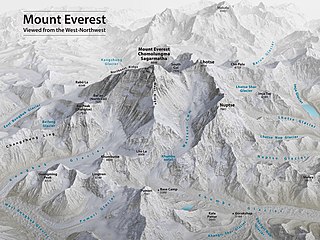Related Research Articles

Guanyin is a Bodhisattva associated with compassion. Guanyin is a common Chinese name for Avalokiteśvara in Chinese Buddhism and has been appropriated by other Eastern religions, including Taoism and Chinese folk religion. Guanyin is short for Guanshiyin, which means "[The One Who] Perceives the Sounds of the World". Due to sociogeographical factors, Guanyin can be historically depicted as genderless or adorning a androgynous apprentice. On the 19th day of the sixth lunar month, Guanyin's attainment of Buddhahood is celebrated.

Mount Everest is Earth's highest mountain above sea level, located in the Mahalangur Himal sub-range of the Himalayas. The China–Nepal border runs across its summit point. Its elevation of 8,848.86 m was most recently established in 2020 by the Chinese and Nepali authorities.

Durga is a major Hindu goddess, worshipped as a principal aspect of the mother goddess Mahadevi. She is associated with protection, strength, motherhood, destruction, and wars.
The Seven Summits are the highest mountains on each of the seven traditional continents. On 30 April 1985, Richard Bass became the first climber to reach the summit of all seven.

The Sherpas are one of the Tibetan ethnic groups native to the most mountainous regions of Nepal and Tibetan Autonomous Region of China. The term sherpa derives from the Tibetan-language words shar and pa, which refer to their geographical origin in eastern Tibet (Kham).

Tenzing Norgay, born Namgyal Wangdi, and also referred to as Sherpa Tenzing, was a Nepalese-Indian Sherpa mountaineer. He was one of the first two people known to certainly reach the summit of Mount Everest, which he accomplished with Edmund Hillary on 29 May 1953. Time named Norgay one of the 100 most influential people of the 20th century.

Saraswati, also spelled as Sarasvati, is the Hindu goddess of knowledge, music, flowing water, abundance and wealth, art, speech, wisdom, and learning. She is one of the Tridevi, along with the goddesses Lakshmi and Parvati. She is a pan-Indian deity, also revered in Jainism and Buddhism.

Cho Oyu is the sixth-highest mountain in the world at 8,188 metres (26,864 ft) above sea level. Cho Oyu means "Turquoise Goddess" in Tibetan. The mountain is the westernmost major peak of the Khumbu sub-section of the Mahalangur Himalaya 20 km west of Mount Everest. The mountain stands on the China–Nepal border, between the Tibet Autonomous Region and Koshi Province.

Wanda Rutkiewicz was a Polish mountaineer and computer engineer. She was the first woman to reach the summit of K2 and the third woman to summit Mount Everest.

Edmund Viesturs is an American high-altitude mountaineer, corporate speaker, and well known author in the mountain climbing community. He was the first American to climb all 14 of the eight-thousander mountains, and the 5th person to do so without supplemental oxygen. Along with Apa Sherpa, he has summitted eight-thousanders on 21 occasions, including Mount Everest seven times.

Yasuko Namba was the second Japanese woman to climb the Seven Summits. Namba worked as a businesswoman for Federal Express in Japan, but her hobby of mountaineering took her all over the world. She first summited Kilimanjaro on New Year's Day in 1982, and summited Aconcagua exactly two years later. She reached the summit of Denali on July 1, 1985, and the summit of Mount Elbrus on August 1, 1992. After summiting Vinson Massif on December 29, 1993, and Carstensz Pyramid on November 12, 1994, Namba's final summit to reach was Mount Everest. She signed on with Rob Hall's guiding company, Adventure Consultants, and reached the summit in May 1996, but died during her descent in the 1996 Mount Everest disaster.

Mount Everest is the world's highest mountain, with a peak at 8,849 metres (29,031.7 ft) above sea level. It is situated in the Himalayan range of Solukhumbu district, Nepal.

Kali, also called Kalika, is a major Hindu goddess associated with time, change, creation, power, destruction and death in Shaktism. Kali is the first of the ten Mahavidyas in the Hindu tantric tradition.
Ming Kipa is a Nepalese Sherpa woman who held the record as the youngest person to climb Mount Everest from 2003 to 2010. She reached the summit on May 22, 2003 when she was 15 years old, with her brother Mingma Gyula and her sister Lhakpa. Nepalese law does not allow climbers under 16 to climb Everest, so Ming Kipa Sherpa summitted Everest from the Chinese side. Her record was broken in 2010 when Jordan Romero reached the summit on May 22 of that year at the age of 13 years, 10 months. The previous record holder was Temba Tsheri who climbed Everest at the age of 16 in 2001.
Gülnur Tumbat is a Turkish female academic in marketing as well as amateur mountain climber and ultramarathon runner. Currently, she lives in San Francisco, California.
Lhakpa Sherpa is a Nepalese Sherpa mountain climber. She has climbed Mount Everest ten times, the most of any woman in the world. Her record-breaking tenth climb was on May 12, 2022, which she financed via a crowd-funding campaign. In 2000, she became the first Nepali woman to climb and descend Everest successfully. In 2016, she was listed as one of BBC's 100 Women.

Mount Everest in 2018 is about events in the year about the highest Earth mountain, Mount Everest, a popular mountaineering tourism and science destination in the 2010s. In 2018, 807 climbers summited Mount Everest, which is a popular mountaineering goal. This year is noted for an especially long weather window of 11 days straight of calm, which reduced crowding at the high base camps. With over 800 reaching the top, it was the highest amount ever to reach the top in recorded history, besting the previous year by over 150 summitings.

Orianne Aymard is an author, speaker, and mountaineer from Clamart, France. She lives in Chamonix.
References
- ↑ Bernbaum, Edwin (2022-03-10). Sacred Mountains of the World. Cambridge University Press. p. 20. ISBN 978-1-108-89249-0.
- ↑ "Miyolangsangma, the Goddess of Inexhaustible Giving | Tsem Rinpoche". www.tsemrinpoche.com. Retrieved 2023-05-06.
- ↑ Everest: Summit of Achievement. Simon and Schuster. 2003. pp. 51–52. ISBN 978-0-7432-4386-5.
- ↑ "Miyolangsangma". Mandalas Life. Retrieved 2023-05-06.